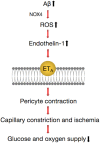New Insights Into the Pathogenesis of Alzheimer's Disease
- PMID: 31998208
- PMCID: PMC6965067
- DOI: 10.3389/fneur.2019.01312
New Insights Into the Pathogenesis of Alzheimer's Disease
Abstract
Alzheimer's disease (AD), a common neurodegenerative disease in the elderly and the most prevalent cause of dementia, is characterized by progressive cognitive impairment. The prevalence of AD continues to increase worldwide, becoming a great healthcare challenge of the twenty-first century. In the more than 110 years since AD was discovered, many related pathogenic mechanisms have been proposed, and the most recognized hypotheses are the amyloid and tau hypotheses. However, almost all clinical trials targeting these mechanisms have not identified any effective methods to treat AD. Scientists are gradually moving away from the simple assumption, as proposed in the original amyloid hypothesis, to new theories of pathogenesis, including gamma oscillations, prion transmission, cerebral vasoconstriction, growth hormone secretagogue receptor 1α (GHSR1α)-mediated mechanism, and infection. To place these findings in context, we first reviewed the neuropathology of AD and further discussed new insights in the pathogenesis of AD.
Keywords: Alzheimer's disease; amyloid; gamma rhythm; ghrelin; infection; pericytes; prions; tauopathies.
Copyright © 2020 Fan, Mao, Hu, Zhang, Yang, Hu, Sun, Fan, Dong, Yang, Shi and Xu.
Figures





References
-
- Alzheimer's disease facts and figures Alzheimers Dement. (2018) 14:367–429. 10.1016/j.jalz.2018.02.001 - DOI
Publication types
LinkOut - more resources
Full Text Sources
Other Literature Sources

